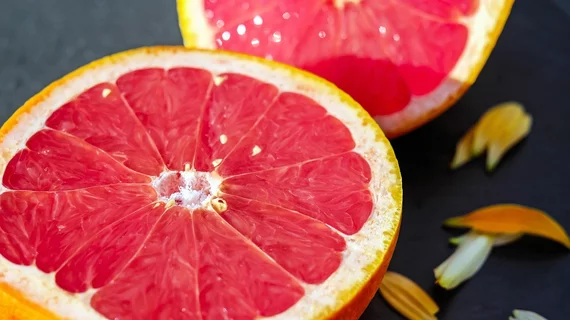A high intake of grapefruit juice—and other dietary flavonoids found in fruits, vegetables, tea and wine—could correspond to QT interval prolongation in healthy individuals and those with heart disease, leaving them vulnerable to serious arrhythmias like torsades-de-pointes.
Some 200 medications currently warn of QT prolongation, first author Ehud Chorin, MD, PhD, and colleagues at Tel Aviv Sourasky Medical Center and Tel Aviv University wrote in Heart Rhythm, including 57 with a confirmed risk of the potentially fatal torsades-de-pointes. Those drugs typically prolong the QT interval—an electrocardiographic indication of the time it takes for a patient’s heart to contract and refill with blood—by blocking a specific potassium channel on the myocardial cell membrane. Chorin and his co-authors said some foods, too, might provoke the same blockage.
Building on a 2005 study that connected flavonoids in pink grapefruit juice to QT prolongation in a small group of healthy volunteers, Chorin et al. recruited 30 healthy participants and 10 patients with congenital long QT syndrome (LQTS) for their research. They tested the effects of drinking grapefruit juice on the population in a thorough-QT-study—the same method the pharmaceutical industry uses to vet new drugs.
Healthy volunteers were randomized to drink 2 liters of grapefruit juice or receive 400 mg of oral moxifloxacin, an antibiotic and the positive control used most often to imitate QT prolongation in pharmaceutical studies. Because of their existing risk, LQTS patients were only tested with grapefruit juice.
Chorin and colleagues said patient ECGs revealed grapefruit juice yielded “significant” elongation of the QT interval, with an absolute net prolongation of 14 milliseconds. The QT-prolonging effects of grapefruit in healthy volunteers were similar to those of moxifloxacin, though they were greater in women and patients with LQTS.
The authors said QT prolongation as a result of ingesting grapefruit juice first became statistically significant around three hours after the patient drank their first liter and peaked around four and a half hours in.
“The grapefruit-induced QT prolongation lasted to the end of the measurement period, with QT values significantly longer than the corresponding off-drug measurements throughout hours 3-7 after the first dose,” they wrote. “Direct comparison between the peak effect of moxifloxacin and grapefruit juice showed that moxifloxacin had a stronger, yet non-statistically significant different effect on QT prolongation with a difference of 6.9 milliseconds compared with grapefruit juice.”
Chorin et al. said the average increase in QT intervals they observed was relatively small, but from the point of view of regulatory agencies it’s somewhat significant. If grapefruit juice really were a new drug in the testing process, the team’s results would indicate a need for further, more in-depth research before any final conclusions could be reached.
Still, the authors said they could definitively recommend avoiding grapefruit when taking known QT-prolonging drugs, since the fruit can increase the proarrhythmic potential of such medications by inhibiting their metabolism. Chorin and colleagues also said patients with LQTS should be wary of drinking large quantities of grapefruit juice in short periods of time.
“When patients with LQTS present with torsades-de-pointes, it is common practice to inquire about recently consumed drugs,” they wrote. “We suggest that the medical history intake in such cases should also include questions about recently consumed food products. We have known proarrhythmic drugs for more than 44 years; we may soon be discussing ‘proarrhythmic food.’”

